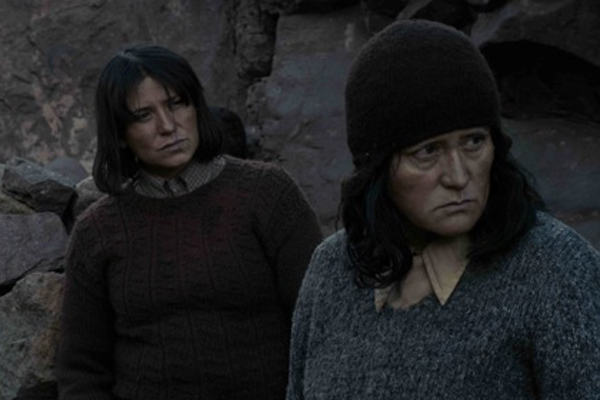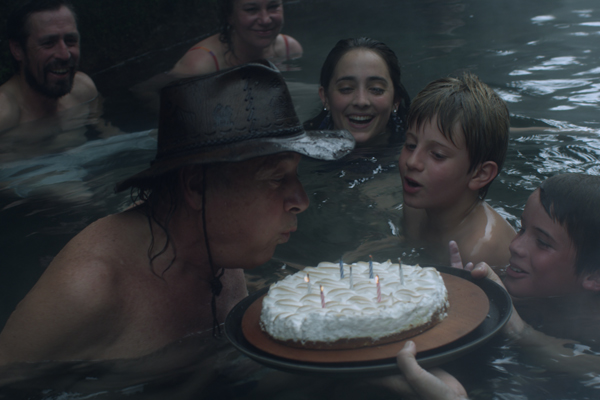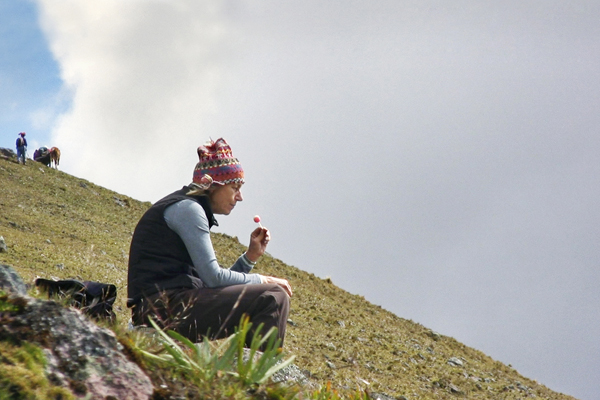Modern Americans
As part of its annual film festival, First Look, Museum of the Moving Image will show three films from South America, The Quispe Girls, Looking for Adventure, and The Summer of Flying Fish on Sunday, January 12, 2014. Director Kimi Takesue will be present at the screening of Looking for Adventure.
The film The Quispe Girls (2013) opens
on a barren, windswept field in northern Chile. Soon, a human voice calls “Come
on, come on!, and a herd of goats and sheep streams forward, filling the space
with life. The animals belong to three adult sisters who have made their home
in a nearby cave. It is 1974, the year following the start of Augusto
Pinochet’s military dictatorship, and like many rural Chileans, the women have
been pushed far towards society’s margins in its wake. The eldest sister, Justa
(played by Digna Quispe), insists that they are best off staying isolated where
they are for as long as they can to avoid soldiers; the youngest, Luciana
(Francisca Gavilán), clamors to look for people and rejoin society; and the
middle child, Lucia (Catalina Saavedra), hovers uncertainly in between.
Sebastián Sepúlveda’s debut feature is one of three South American films screening
at the Museum of the Moving Image as part of its international film festival First Look, with all three films
receiving their U.S. premieres. The
Quispe Girls presents the sisters’ situation and dynamic clearly in order
for the viewer to consider it at length. We learn early on that there once was
a fourth and senior sister named Maria, who died some time before the story’s
beginning and whose absence works to leave all of them all feeling unmoored.
This is especially true of Justa, who hides her fears and doubts behind a stone
mask of authority while her group’s resources dwindle. Her younger sisters go
from openly wondering who will buy their cheese to learning (during a brief
visit from an older man selling clothes) that the government has passed a law
to slaughter goats in order to protect its fences. By demanding resources for
itself, the country’s leadership is threatening to leave people like the
sisters without any.

The Quispe Girls
Throughout The Quispe Girls runs the
feeling of a rope tightening around them. Yet while a sense of inevitable death
looms in the film, so does one of life continuing. Sepúlveda has adapted his
movie both from Las Brutas, a 1980
play by Juan Radrigán, and from the true story on which it was based. The carefully
rendered areas of the Chilean Altiplano in which the action unfolds, including
the cave and its surroundings, are where the Quispe sisters actually lived during
their last days; the compelling, mysterious performer playing Justa is not just
a present-day native of the place, but also the Quispe sisters’ niece in real
life and the last person to see them alive.
The other two actresses are Chilean movie stars. The tension between Digna
Quispe’s flat stoniness and their actorly emoting helps create a kind of
theatrical realism, in which artifice is highlighted in order to call attention
to things that an artist can catch but cannot stage: Bursts of sunlight piercing
shadows to reach a person’s face; the sound of wind softly blowing through
grass as someone strides from one part of a plain to another; the absorption of
Nature’s details as one prepares to bid them goodbye.
Part of Sepúlveda’s reworking of Radrigán’s claustrophobic, argument-heavy play
has involved moving much of the tale’s action outdoors and replacing dialogue
with moments of silence. The result turns verbal poetry into visual poetry, though
perhaps to a similar end. While the film presents death as an escape from life,
it does not make choosing death out to be cowardly. If the modern world abandons
these girls, then they will join their older sister.
The other Chilean film screening in First
Look points to how the Pinochet regime’s efforts to move Chile forward
impacted indigenous peoples as well as farmers and herders. Efforts by democratic
leaders’ efforts to repatriate native land in the 1960s and 1970s were reversed
during the dictatorship, with the land privatized for businesses such as timber
companies. Even after democracy was restored to Chile in 1990, struggles
between the government and local elites on one side and the Mapuche (an
ethnicity encompassing about 80 percent of Chile’s indigenous peoples and
nearly a tenth of the general population) on the other side have continued. In
recent years, legislation has been passed in Chile protecting the rights of
native cultures; industrialization has also led to forced relocations, and
Mapuche activism has been regulated with antiterrorism laws.

The Summer of Flying Fish
The Summer of Flying Fish (2013) tells this ongoing story, essentially from
the point of view of the conquerors. Its main character is Manena (Francisca
Walker), a wealthy teenage girl from Santiago. She has moved with her family to
a forest area in the South of Chile near Patagonia, where her landowner father,
Pancho (Gregory Cohen), is steadily claiming the area’s resources with local
help. His employees include Pedro (Roberto Cayuqueo), a shy Mapuche boy who
gradually exposes his love for rock music to Manena, and in whom Manena’s interest
steadily grows.
Filmmaker Marcela Said, creating her first fiction film following four
documentaries, has chosen to tell Summer largely
from Manena’s point of view. This choice lends the film a strong documentary
element, with the viewer absorbing and discovering landscapes of the Aruacanía
and Los Rios regions at the same time as Manena does; it also simultaneously
gives the work a quality of dramatic irony, with much of the story’s action hovering
just beyond what Manena can see.
Scenes of the Mapuche conflict are rarely shown onscreen in the film, as are
any Mapuche people aside from Pedro. Summer instead gives several moments of Manena and other new residents to the area
walking and swimming through their forest surroundings, or else relaxing in
their large homes, attended by servants. The film implies that these casual
moments of discovery and pleasure have come from a new breed of colonialism, in
which transplanted white people enjoy themselves in a new place thanks to the
work of unseen darker-skinned people that have cultivated it for centuries.
Meanwhile, violence breaks out around the edges of the frame. One of the film’s
first scenes shows Manena in a car with her family members, witnessing police
cordoning off an area for reasons that her father races past too quickly for
her to discern. The reasons are hinted at in Pancho’s subsequent ongoing quest
to blow up the carp fish pervading the water around his new home, which risks
driving himself and others around him deaf. His efforts (which Said and co-screenwriter
Julio Rojas based on a true story) serve as a metaphor for local powers hurting
themselves in the name of self-protection. They will gain resonance as he
attempts to purge himself of native influences in the name of his family while driving
its members away..
Pancho’s actions—increasingly violent, and increasingly met with native
resistance—particularly impact the relationship between Pedro and Manena. In
time, the girl becomes less willing to accept her patriarch’s gifts, and more
sympathetic and open to new friends. The viewer, in sharing Manena’s position,
sees life through the eyes of a naïve, privileged person growing aware of her
privilege’s source. What she will ultimately do with this knowledge remains, at
film’s end, unsaid.

Looking for Adventure
Looking for Adventure also critiques
industrialization—specifically, the tourist industry. U.S.-born Kimi Takesue’s
film, shot on a two-week trip to Peru with her mother, features a wide variety
of foreign visitors, including Americans, Brazilians, and Japanese people,
whose words tend to merge into a great babble. The tourists are presented
across a series of tableaux involving visits to urban centers, historical
sites, mountains, and large bodies of water, all led by colorfully costumed
(and similarly babbling) local guides. The newcomers dive into pointing and
asking questions about what they see, as well as into taking pictures and eating;
at other points, they look bored or even asleep, as though waiting for someone to
tell them when the next adventure should begin.
The film’s title should therefore likely be seen as playfully ironic,
especially when tourists photograph themselves in restaurant mirrors. Takesue includes
herself within the joke. The fixed, distant setup of many of the shots is so
formal as to announce the offscreen presence of the filmmaker (who will appear
in person at the Moving Image screening). She is also a tourist, with the
people in front of her serving as her guides, and her way of calling attention
to herself behind her camera pokes fun at any tourist’s desire to go native.
Takesue has previously employed this method of making a game between herself
and the strangers she’s filming in several works, including her 2010 feature Where Are You Taking Me?, which began
with a Rotterdam commission to make a work for a program of films about Africa.
Takesue filmed several scenes taking place in Uganda across settings that
included a weightlifting competition, a wedding party, a kickboxing class, and
a Bruce Lee movie screening with an announcer’s running commentary. Whenever local
people in the film stop to stare at her camera, let alone speak into it, Takesue
appears at least as foreign to them as they might be to her. The foreigners, both
onscreen and offscreen, form a collaboration that makes the film. It might
initially seem perverse to call Where Are
You Taking Me? both an American and a Ugandan movie, but if an American and
Ugandans are shaping the film together, then why not?
Similarly, Looking for Adventure is
formally listed as a U.S./Peru co-production, a matter that goes beyond
funding. While counting the film as one of First
Look’s three South American works is admittedly meant as a small
provocation, doing so points to a duality that the film itself raises. Looking for Adventure’s native Peruvians
appear almost exclusively onscreen as guides, hosts, waiters serving native
food, dance instructors leading native dances, and indigenous street vendors
selling native clothes. All of them are, at some level, performing for her, and
living to serve their country’s guests. The film presents not just Peru as the
tourists see it, but also a Peruvian identity shaped in collaboration with
tourists. The result is a place where tourism helps build daily life.
Thanks to Bruno Bettati and to José Miguel Palacios for research help.
Aaron Cutler works as a programming aide for the São Paulo International Film Festival and keeps a film criticism site, The Moviegoer. ![]()
LATEST ARTICLES
-20140814-173707-thumb3.jpg)
Fighting Words
by Imogen Sara Smith
posted August 12, 2014

Fighting Words, Part 2
by Imogen Sara Smith
posted August 20, 2014

On the Margins: The Fil…
by Andrew Chan
posted August 12, 2014

Robin Williams: A Sense…
by David Schwartz
posted August 12, 2014
 Modern Americans
Modern Americans
THE AUTHOR
Aaron Cutler is a writer in São Paulo. His film writings can be found at http://aaroncutler.tumblr.com.
More articles by Aaron Cutler
